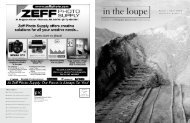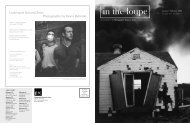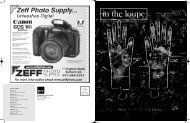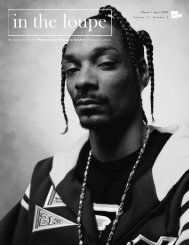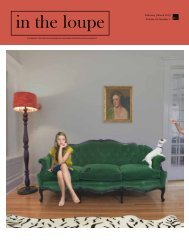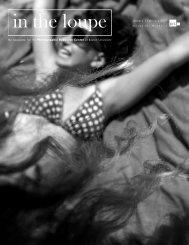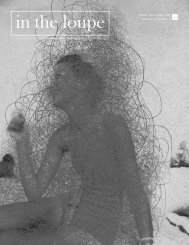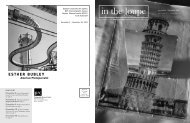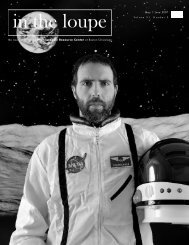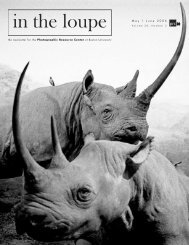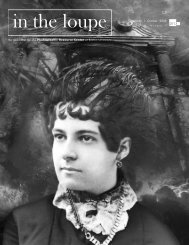January | February 2006 - Boston Photography Focus
January | February 2006 - Boston Photography Focus
January | February 2006 - Boston Photography Focus
You also want an ePaper? Increase the reach of your titles
YUMPU automatically turns print PDFs into web optimized ePapers that Google loves.
Installation shot of Jaimi Laird touching James Patten’s piece at<br />
the Piano Factory Gallery, July 2005. James Patten (Cambridge,<br />
MA), “Tactile Photograph” of Mariliana Arvelo’s Nagala’at<br />
performers II, Watertown, MA, 2004, CNC laser etching on<br />
wood, 2005, 15 x 24 inches, Courtesy of the artists.<br />
DOCUMENT showcases recent social<br />
documentary work from <strong>Boston</strong> on <strong>Boston</strong><br />
through the eyes of 9 emerging to early midcareer<br />
photographers. The title of this exhibition,<br />
DOCUMENT, is itself a call to arms as<br />
well as a record. As a verb, the word “document”<br />
implies the act of furnishing factual<br />
support or portraying what is in front of you.<br />
As a noun, “document” references the proof<br />
or evidence. Any exhibition itself is all of these<br />
things and more—a time capsule of what is<br />
deemed important at that time, culturally and<br />
aesthetically, by both the artists and the curator.<br />
Unfortunately, social documentary work<br />
rarely finds its way into galleries, commercial<br />
or non-profit, and increasingly so, the press.<br />
Nevertheless, <strong>Boston</strong> has a long tradition of<br />
documentary work, burgeoning especially<br />
in the 1970s and 80s—from its production<br />
to exhibition, collection, and publication. 1<br />
Acknowledging the important endeavors<br />
that have come before, and even the recent<br />
National Millennium Survey (1995-2000), this<br />
exhibition respectfully offers up for consideration<br />
a new slate of regional photographers,<br />
methodologies, and projects. 2 Borrowing<br />
a phrase from the prospectus of the NEAfunded<br />
“<strong>Boston</strong> Photo-Documentary Project”<br />
from the early 1980s of which PRC founder<br />
Chris Enos was a part, the photographers<br />
featured in DOCUMENT build upon this<br />
groundwork and equally serve as “historians<br />
of the present.” 3<br />
DOCUMENT is held in conjunction with<br />
the <strong>Boston</strong> University Art Gallery’s exhibition<br />
A Photographic Portrait of <strong>Boston</strong>, 1840-1865<br />
(<strong>February</strong> 10 - April 2, <strong>2006</strong>) and will coincide<br />
with the College Art Association’s (CAA)<br />
national conference, which will be held in<br />
<strong>Boston</strong>, <strong>February</strong> 22-25, <strong>2006</strong>. In addition,<br />
<strong>Boston</strong> University’s School of Visual Arts is<br />
sponsoring and hosting a juried BFA show for<br />
CAA featuring work by 14 New England area<br />
art programs in the 808 Gallery. Interestingly<br />
enough, almost all of the photographers in<br />
the PRC’s show are not originally from this<br />
area. Given this region’s strength in education,<br />
photographers are often drawn to the city<br />
and stay, lending their unique perspectives to<br />
Greater <strong>Boston</strong>.<br />
BOSTON AND<br />
THE DOCUMENT SCENE<br />
Admittedly so, DOCUMENT offers forth a<br />
very wide swath of topics and approaches.<br />
While this selection does hope to be an<br />
introduction to socially-oriented and sociallyconscious<br />
work going on in and about the<br />
city today, it does not claim to be complete.<br />
It concentrates on people-based work and<br />
saves the natural and built environment (two<br />
elements very unique in and to <strong>Boston</strong>) for<br />
another project and future consideration.<br />
Likewise, just as each selected topic differs<br />
vastly—ranging from Somerville firefighters<br />
to the homeless in Chinatown—so does each<br />
photographer’s method. A number of photographers<br />
use one particular group or person<br />
to elaborate on issues that are specifically<br />
<strong>Boston</strong>-related, and others showcase issues<br />
that affect the whole nation through a local<br />
connection. Several photographers incorporate<br />
a significant amount of text and context; others<br />
aim for minimalism and overall aesthetic<br />
effect. This balance between “art” and “document”<br />
is an ongoing debate within academia<br />
and documentary photography and recapitulated<br />
periodically. Indeed, several current<br />
artistic trends are reflected here—interactivity,<br />
the grid, the solo, close-up portrait—but the<br />
photographers attempt to reference or use<br />
them for other aims.<br />
As the PRC beings to celebrate its 30th anniversary,<br />
and we look back to 1976, it is wise<br />
to ingest the lessons learned from the 1970s<br />
photographic documentaries when considering<br />
the work and photographers in DOCU-<br />
MENT. As Mark Rice, chair of the American<br />
Studies department at St. John Fisher College<br />
(Rochester, NY) points out in his insightful<br />
study Through the Lens of the City: NEA<br />
Funded <strong>Photography</strong> Surveys of the 1970s:<br />
[…there is no] “one correct way to undertake<br />
a survey…[no] laundry list of sociological<br />
topics that need to be answered.” 4 Later, he<br />
goes on to remind us of the importance of<br />
these surveys to documentary and art photography<br />
today:<br />
“In part because of these projects, photography<br />
has shaken free from the impossible<br />
burden of objectivity. We are more apt than<br />
our predecessors were to recognize that all<br />
photographs are art and documents, mirrors<br />
and windows, traces and transformations.<br />
Representations of place are inherently<br />
political, and art is always social.” 5<br />
Together, the works and photographers in<br />
DOCUMENT share many of these key sensibilities<br />
and urges. Elements that further unite<br />
the work are the photographers’ passionate<br />
involvement and relationships, often repeated<br />
and often long-term, with their topics and<br />
their subjects. Like any good documentarian<br />
or photojournalist, their desires go beyond<br />
simply clicking the shutter, and it shows.<br />
Their projects are self-conscious and often<br />
self-funded. Most of the projects were born<br />
out of a personal desire to know or experience<br />
more about a certain group or community<br />
matter. Accordingly, many of the artists are<br />
highly involved with a whole host of activist,<br />
support, and charitable organizations.<br />
Furthermore, each of these undertakings<br />
represents only one of many issues in which<br />
the photographers are interested. In order<br />
to fuel such missions, they hold day jobs as<br />
adjunct professors and educators as well as<br />
professional, commercial, and editorial photographers.<br />
What follows is a brief synopsis<br />
of the photographers and projects featured in<br />
DOCUMENT.<br />
MARILIANA ARVELO AND<br />
JAMES PATTEN (Cambridge, MA)<br />
Mariliana Arvelo and James Patten exemplify<br />
a unique partnership and approach to social<br />
documentary. Arvelo began this project<br />
through Jaimi Lard, a remarkable woman<br />
who was born completely deaf with almost<br />
no vision and works in public relations for<br />
the Perkins School for the Blind in Watertown,<br />
MA (perhaps best know for its famous<br />
alumna, Helen Keller). Through Laird,<br />
Arvelo was introduced to a larger deaf-blind<br />
community centered around the Deaf Blind<br />
Contact Center and began to photograph<br />
and learn sign language. Based on Arvelo’s<br />
compelling color photographs, her partner<br />
Patten then designed a computer program to<br />
produce a series of “tactile photographs” on<br />
wood panels through a CNC laser etching<br />
process. The result is a photographic relief<br />
that can be touched and is truly interactive<br />
and educational for people of all abilities.<br />
Born in Caracas, Venezuela, Arvelo graduated<br />
in 2002 from the New England School<br />
of <strong>Photography</strong>, specializing in editorial<br />
photography and photojournalism. Her<br />
work has appeared in several international<br />
publications and been exhibited at the Danforth<br />
Museum of Art (Framingham, MA),<br />
the ARC Gallery (Chicago, IL), and the<br />
Gallery at the Piano Factory (<strong>Boston</strong>, MA),<br />
among others. Originally from Virginia,<br />
Patten has exhibited or performed in venues<br />
such as Art Interactive (Cambridge, MA),<br />
Museum of Modern Art (New York, NY),




